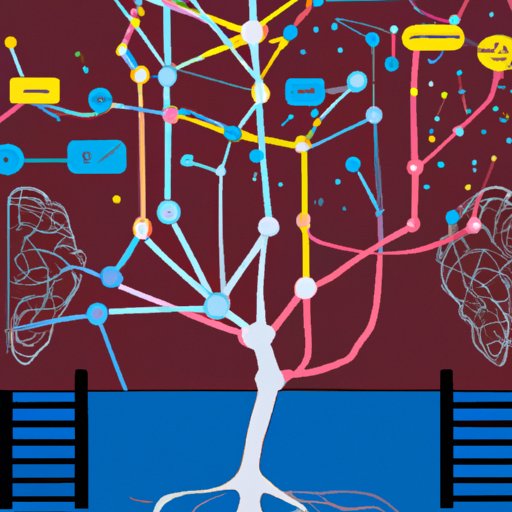Introduction
Artificial intelligence (AI) is a rapidly growing field of technology that enables machines to learn from experience and perform tasks that typically require human intelligence. AI is used for a variety of applications, ranging from healthcare to autonomous vehicles, and it has revolutionized the way we interact with computers. In this article, we will explore the different fields of AI, examine the subfields and applications, and discuss the benefits and challenges of AI.

Exploring the Branches of Artificial Intelligence
The field of AI can be divided into several branches, each focusing on a particular area of research. These include:
- Machine Learning – This branch of AI focuses on developing algorithms that enable machines to learn from data and improve their performance over time without being explicitly programmed.
- Natural Language Processing – This branch of AI deals with analyzing and understanding natural language. It includes tasks such as text analysis, sentiment analysis, and speech recognition.
- Computer Vision – This branch of AI focuses on enabling machines to recognize and understand visual content, such as images and videos.
- Robotics – This branch of AI deals with the development of robots and autonomous agents that are able to interact with the physical world.
- Expert Systems – This branch of AI focuses on developing systems that are able to solve complex problems by reasoning like a human expert.

Examining the Subfields of AI
In addition to the main branches of AI, there are several subfields that focus on more specific areas of research. These include:
- Deep Learning – This subfield of AI focuses on using neural networks to process large amounts of data and detect patterns. By using multiple layers of neurons, these networks are able to learn complex tasks, such as image and speech recognition.
- Reinforcement Learning – This subfield of AI focuses on teaching machines to make decisions and take actions in order to maximize some form of reward.
- Neural Networks – This subfield of AI focuses on creating networks of artificial neurons that are able to process data and solve complex problems.
What Are the Different Types of Artificial Intelligence?
There are three main types of AI:
- Weak AI – This type of AI is designed to perform specific tasks, such as playing chess or solving a Rubik’s cube. It is not capable of generalizing its knowledge to other tasks.
- Strong AI – This type of AI is capable of performing any task that a human can do. It is still in the early stages of development but has the potential to revolutionize the way we interact with computers.
- Superintelligence – This type of AI is capable of performing tasks that are beyond the capabilities of humans. It is still in the theoretical stage but could potentially be used for advanced applications such as medical diagnosis and space exploration.
An In-Depth Look at the Different Areas of AI
AI is being used in a variety of industries and fields, such as:
- Healthcare – AI is being used to diagnose and treat diseases, detect anomalies in medical images, and analyze patient data.
- Autonomous Vehicles – AI is being used to develop self-driving cars, which are able to navigate roads without human intervention.
- Cybersecurity – AI is being used to detect malicious activity and protect networks from cyber threats.
- Smart Homes – AI is being used to automate home systems, such as lighting and heating, and to create intelligent assistants.
Examining the Various Applications of Artificial Intelligence
AI is being used for a variety of applications, such as:
- Automation – AI is being used to automate mundane tasks and streamline business processes.
- Speech and Image Recognition – AI is being used to recognize speech and images, which can be used for applications such as facial recognition and automated customer service.
- Predictive Analytics – AI is being used to analyze data and predict future trends, which can be used for applications such as financial forecasting and fraud detection.
Conclusion
In conclusion, AI is a rapidly growing field of technology that is being used for a variety of applications, ranging from healthcare to autonomous vehicles. The field can be divided into several branches, such as machine learning, natural language processing, computer vision, robotics, and expert systems. There are also several subfields, including deep learning, reinforcement learning, and neural networks. Furthermore, there are three types of AI: weak AI, strong AI, and superintelligence. AI has many potential benefits, such as automation and predictive analytics, but it also presents some challenges, such as the potential for misuse and lack of oversight.
(Note: Is this article not meeting your expectations? Do you have knowledge or insights to share? Unlock new opportunities and expand your reach by joining our authors team. Click Registration to join us and share your expertise with our readers.)
